

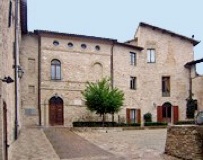
Early History of the Church
Ubertino di Guittone of Assisi paid for a church to be built here in 1088 as part of his penance for murder. He gave it to the Abbazia di Farfa, along with other lands that would provide an annuity for its upkeep, in return for absolution.
-
✴The dedication to St James suggests that Ubertino was also required to make a pilgrimage to Santiago di Compostella.
-
✴The word Murorupto arises because the church was built on the ruins of the Roman city wall, part of which survives in the monastery garden.
The adjoining buildings were used by oblates (lay people who gave their possessions to the church and lived a communal life nearby) in the 11th and. The present church dates to the late 12th century, survive along its right wall. The nearby nunnery of Sant’ Andrea was documented in 1231, when it belonged to San Giacomo.
In 1255, the Abbot of Farfa gave the church to the nuns of San Damiano, and they transferred it to the canons of San Rufino in return for San Giorgio (later Santa Chiara). A small number of nuns from San Damiano probably lived here until 1260, when they were able to move to the new nunnery of Santa Chiara.
Early History of the Benedictine Nunnery
The nuns who settled here in 1323 came originally from San Donato di Flebulle at Colcaprile, outside Assisi. This nunnery was first documented in 1233, when it probably belonged to the Abbazia di San Benedetto al Monte Subasio. This probably accounts for a dispute with the bishop of Assisi, who imprisoned the Abbess Pacifica and appropriated some of the goods of the nunnery in ca. 1241. Pope Gregory IX and Pope Innocent IV intervened on behalf of the nuns, and the situation was resolved in their favour in 1243 (although the nunnery does not appear among the possessions of San Benedetto listed in a papal bull of 1244).
The nuns moved to a site near Santa Chiara in ca. 1320 (probably after the siege that led to the expulsion of Muzio di Francesco in 1321). However, Pope John XXII intervened on behalf of the nuns of Santa Chiara, since Pope Clement IV had decreed that other religious foundations could not be established within 300 canne from their church. (A canna was about 2 meters).
Nunnery next to San Giacomo

Nunnery at San Giacomo
The church of San Giacomo ceased to be a parish church and was given to the nuns in 1458. At this point:
-
✴the nuns also acquired the former home of the parish priest and extended their nunnery, so that San Giacomo was enclosed within it; and
-
✴their old church, which became a public oratory, was rebuilt in 1595.
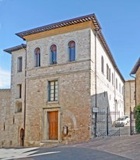
The community was formally suppressed in 1860 but managed to retain its identity. In 1897, the nuns bought and moved to the ex-Monastero di Sant Apollinare and re-dedicated it as the Monastero delle Benedettine di San Giuseppe. In 1902, the author Harold Goad established the Laboratorio Ricreatorio San Francesco di Assisi, a charity for the education of young women that was administered by the Suore Francescane Angeline in their old church. It was recently restored and adapted as a theatre.
Church of San Giacomo
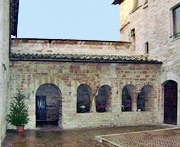
The door on the left above leads to an inner courtyard and the remains of a cloister (11th century) that now forms a portico to the church.
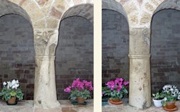
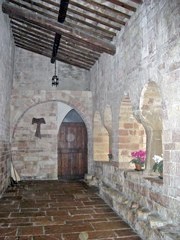
Interior


The church has a single nave and transept, with a shallow apse and two low apsidal chapels.
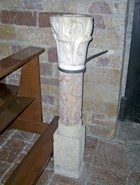
Frescoes
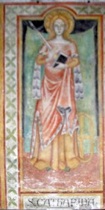

There are two interesting frescoes by local artists on the left wall, depicting:
-
✴St Catherine of Alexandria (late 14th century); and
-
✴the Madonna and Child (mid 15th century).
Return to Nunneries of Assisi.
Return to Monuments of Assisi.
Return to Walk III.
Return to the home page on Assisi.

